CPR
Article Translations: (Spanish) (Somali)
CPR stands for cardiopulmonary resuscitation.
C = cardiac (heart)
P = pulmonary (lungs)
R = resuscitation (to recover)
Adult is puberty and older.
Child is one year old to puberty.
Infant is up to a year old.
Check for response
- Support the head and neck, and turn the person so he or she lays flat, face-up, on a hard surface.
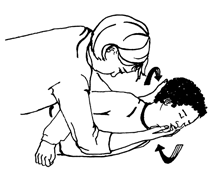
- Tap and shout, "Are you okay?"
- If no response, yell, "Help!"
- If someone comes, send person to call 911 and get automatic external defibrillator (AED) if available.
- If you are alone, go call 911; with infants and children begin 2 minutes of CPR before calling. Get AED if available. - Check for no breathing or no normal breathing (such as gasping) for 5 to 10 seconds:
C - Chest Presses
1. Quickly open chest clothing.
Adult:
- Put the heel of one hand between the nipples on the breastbone.
- Put the other hand over the first, keeping your fingers off the chest and your elbows straight.
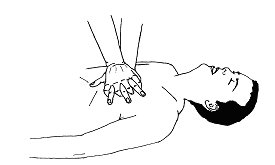
Child:
- Put the heel of one hand between the nipples on the breastbone. (Put other hand on top if needed.)
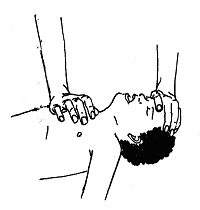
Infant:
- Put 2 fingers on the breastbone, just below the nipple line. (Make sure your fingers are not on the bottom end of the breastbone.)
- OR cup your hands around the chest with both hands, thumbs meeting in the center of the chest on the breastbone.


4. Push hard and fast:
- Push straight down
- 2 inches deep for child or adult.
- 1/3 the depth of the chest (about 1½ inches) in infants.
- 30 pushes at a rate of at least 100 per minute
- Let chest come up after each push
Use AED as soon as it is available.
A - Airway
Open airway with a head-tilt/chin-lift method.
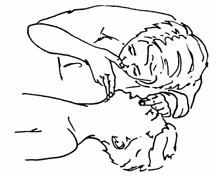
If you do not feel comfortable delivering breaths to a person, continue to do chest pushes.
B - Breathing
- Seal the mouth with your mouth. Pinch the nose for child and adult
- Seal the mouth and nose with your mouth for infants.
- Give 2 breaths, just enough to make the chest rise (about 1 second each)
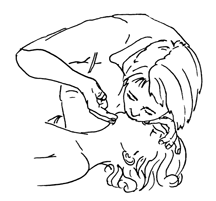
- If chest does not rise, reposition the head and try 2 more breaths. If the chest still does not rise, the airway is blocked. Continue chest pushes, but look in the airway before giving a breath. If you see something, remove it.
Continue 30 compressions and 2 breaths for 5 cycles or about 2 minutes.
Do CPR until person is responding (starting to move), or until trained help takes over.
If breathing but not responding:
- Stop CPR.
- Watch the breathing until trained help arrives.
- If no injuries, roll the person onto one side. Do not twist the head, neck, or body while rolling.
- Even if breathing and responding, the person should be taken to the nearest emergency room by ambulance.
Important
This sheet is a review of techniques taught in a CPR class. It is not complete in itself. You must practice these techniques on a manikin with an instructor. Do not practice techniques on a person.
CPR Quick reference
| C - Check for response | |
Alert:
Chest pushes:
|
|
| A - Airway | |
|
 |
| B - Breathing | |
|
 |
Family and Friends CPR Program
Children's Minnesota offers a FREE CPR program for family and friends. To sign up, call 651-220-5279 and press #1 for Minneapolis campus and #2 for the St. Paul campus.
Questions?
This information is not specific to your child but provides general information. If you have any questions, please call your clinic or health care professional.
Reviewed 1/21
This page is not specific to your child, but provides general information on the topic above. If you have any questions, please call your clinic. For more reading material about this and other health topics, please call or visit Children's Minnesota Family Resource Center library, or visit www.childrensmn.org/educationmaterials.
© 2024 Children's Minnesota
